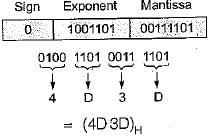Computer Science Engineering (CSE) Exam > Computer Science Engineering (CSE) Questions > The decimal number 0.239 x 213 has the follow...
Start Learning for Free
The decimal number 0.239 x 213 has the following hexadecimal representation (without normalization and rounding off:
- a)0D 24
- b)0D 4D
- c)4D 0D
- d)4D 3D
Correct answer is option 'D'. Can you explain this answer?
Verified Answer
The decimal number 0.239 x 213 has the following hexadecimal represent...
The decimal number is 0.239 x 213
We have to find hexadecimal representation without normalization.
Biased exponent = 13 + 64 = 77
Representing 77 in binary (77)10 = (1001101)2
Representing mantissa in binary
senting mantissa in binary (0.239)10 = 0.00111101000101

We have to find hexadecimal representation without normalization.
Biased exponent = 13 + 64 = 77
Representing 77 in binary (77)10 = (1001101)2
Representing mantissa in binary
senting mantissa in binary (0.239)10 = 0.00111101000101

Most Upvoted Answer
The decimal number 0.239 x 213 has the following hexadecimal represent...
The given decimal number is 0.239 multiplied by 213. We need to find its hexadecimal representation without normalization and rounding off.
To solve this problem, we will follow the steps below:
1. Multiply the decimal number by 213:
0.239 * 213 = 51.007
2. Convert the integer part of the result to hexadecimal:
51 (in decimal) = 33 (in hexadecimal)
3. Convert the fractional part of the result to hexadecimal:
To convert the fractional part, we will multiply it by 16 repeatedly and take the integer part at each step until we get zero or the desired precision.
0.007 * 16 = 0.112
0.112 * 16 = 1.792
0.792 * 16 = 12.672
4. Combine the hexadecimal representations of the integer and fractional parts:
The integer part is 33, which is represented as 21 in hexadecimal.
The fractional part is 0.112, which is represented as 0.1 in hexadecimal.
Therefore, the hexadecimal representation of the decimal number 0.239 * 213 is 21.1.
5. Rearrange the digits to match the given options:
The given options are:
a) 0D 24
b) 0D 4D
c) 4D 0D
d) 4D 3D
Among these options, option d) 4D 3D matches the hexadecimal representation we found in step 4, which is 21.1. Therefore, the correct answer is option d) 4D 3D.
By following these steps, we have determined that the hexadecimal representation of the decimal number 0.239 * 213 is 4D 3D.
To solve this problem, we will follow the steps below:
1. Multiply the decimal number by 213:
0.239 * 213 = 51.007
2. Convert the integer part of the result to hexadecimal:
51 (in decimal) = 33 (in hexadecimal)
3. Convert the fractional part of the result to hexadecimal:
To convert the fractional part, we will multiply it by 16 repeatedly and take the integer part at each step until we get zero or the desired precision.
0.007 * 16 = 0.112
0.112 * 16 = 1.792
0.792 * 16 = 12.672
4. Combine the hexadecimal representations of the integer and fractional parts:
The integer part is 33, which is represented as 21 in hexadecimal.
The fractional part is 0.112, which is represented as 0.1 in hexadecimal.
Therefore, the hexadecimal representation of the decimal number 0.239 * 213 is 21.1.
5. Rearrange the digits to match the given options:
The given options are:
a) 0D 24
b) 0D 4D
c) 4D 0D
d) 4D 3D
Among these options, option d) 4D 3D matches the hexadecimal representation we found in step 4, which is 21.1. Therefore, the correct answer is option d) 4D 3D.
By following these steps, we have determined that the hexadecimal representation of the decimal number 0.239 * 213 is 4D 3D.

|
Explore Courses for Computer Science Engineering (CSE) exam
|

|
Similar Computer Science Engineering (CSE) Doubts
Question Description
The decimal number 0.239 x 213 has the following hexadecimal representation (without normalization and rounding off:a)0D 24b)0D 4Dc)4D 0Dd)4D 3DCorrect answer is option 'D'. Can you explain this answer? for Computer Science Engineering (CSE) 2025 is part of Computer Science Engineering (CSE) preparation. The Question and answers have been prepared according to the Computer Science Engineering (CSE) exam syllabus. Information about The decimal number 0.239 x 213 has the following hexadecimal representation (without normalization and rounding off:a)0D 24b)0D 4Dc)4D 0Dd)4D 3DCorrect answer is option 'D'. Can you explain this answer? covers all topics & solutions for Computer Science Engineering (CSE) 2025 Exam. Find important definitions, questions, meanings, examples, exercises and tests below for The decimal number 0.239 x 213 has the following hexadecimal representation (without normalization and rounding off:a)0D 24b)0D 4Dc)4D 0Dd)4D 3DCorrect answer is option 'D'. Can you explain this answer?.
The decimal number 0.239 x 213 has the following hexadecimal representation (without normalization and rounding off:a)0D 24b)0D 4Dc)4D 0Dd)4D 3DCorrect answer is option 'D'. Can you explain this answer? for Computer Science Engineering (CSE) 2025 is part of Computer Science Engineering (CSE) preparation. The Question and answers have been prepared according to the Computer Science Engineering (CSE) exam syllabus. Information about The decimal number 0.239 x 213 has the following hexadecimal representation (without normalization and rounding off:a)0D 24b)0D 4Dc)4D 0Dd)4D 3DCorrect answer is option 'D'. Can you explain this answer? covers all topics & solutions for Computer Science Engineering (CSE) 2025 Exam. Find important definitions, questions, meanings, examples, exercises and tests below for The decimal number 0.239 x 213 has the following hexadecimal representation (without normalization and rounding off:a)0D 24b)0D 4Dc)4D 0Dd)4D 3DCorrect answer is option 'D'. Can you explain this answer?.
Solutions for The decimal number 0.239 x 213 has the following hexadecimal representation (without normalization and rounding off:a)0D 24b)0D 4Dc)4D 0Dd)4D 3DCorrect answer is option 'D'. Can you explain this answer? in English & in Hindi are available as part of our courses for Computer Science Engineering (CSE).
Download more important topics, notes, lectures and mock test series for Computer Science Engineering (CSE) Exam by signing up for free.
Here you can find the meaning of The decimal number 0.239 x 213 has the following hexadecimal representation (without normalization and rounding off:a)0D 24b)0D 4Dc)4D 0Dd)4D 3DCorrect answer is option 'D'. Can you explain this answer? defined & explained in the simplest way possible. Besides giving the explanation of
The decimal number 0.239 x 213 has the following hexadecimal representation (without normalization and rounding off:a)0D 24b)0D 4Dc)4D 0Dd)4D 3DCorrect answer is option 'D'. Can you explain this answer?, a detailed solution for The decimal number 0.239 x 213 has the following hexadecimal representation (without normalization and rounding off:a)0D 24b)0D 4Dc)4D 0Dd)4D 3DCorrect answer is option 'D'. Can you explain this answer? has been provided alongside types of The decimal number 0.239 x 213 has the following hexadecimal representation (without normalization and rounding off:a)0D 24b)0D 4Dc)4D 0Dd)4D 3DCorrect answer is option 'D'. Can you explain this answer? theory, EduRev gives you an
ample number of questions to practice The decimal number 0.239 x 213 has the following hexadecimal representation (without normalization and rounding off:a)0D 24b)0D 4Dc)4D 0Dd)4D 3DCorrect answer is option 'D'. Can you explain this answer? tests, examples and also practice Computer Science Engineering (CSE) tests.

|
Explore Courses for Computer Science Engineering (CSE) exam
|

|
Signup to solve all Doubts
Signup to see your scores go up within 7 days! Learn & Practice with 1000+ FREE Notes, Videos & Tests.


























